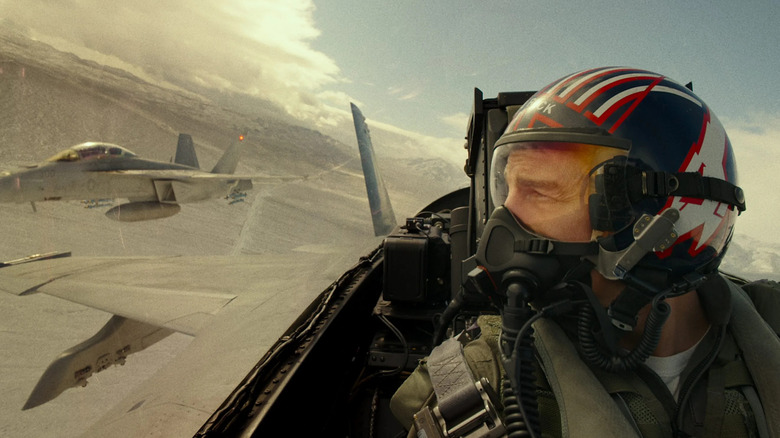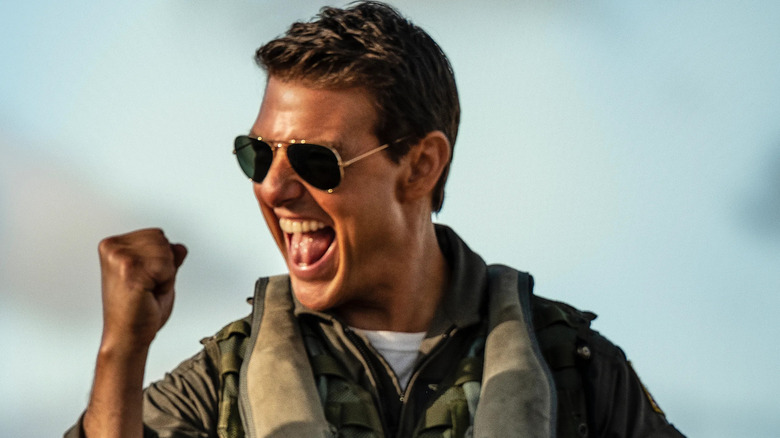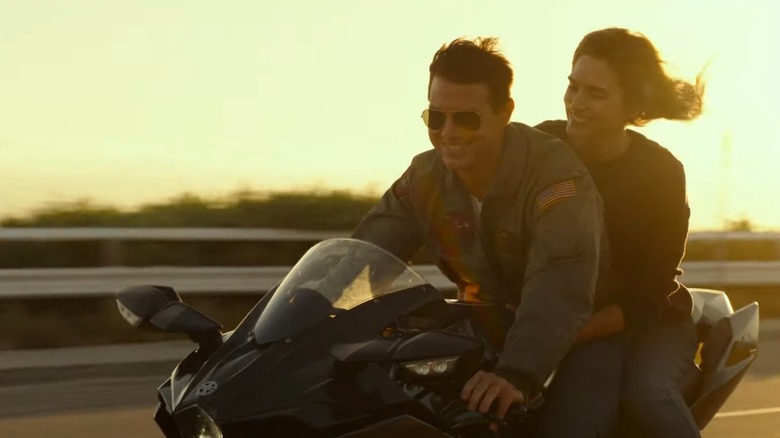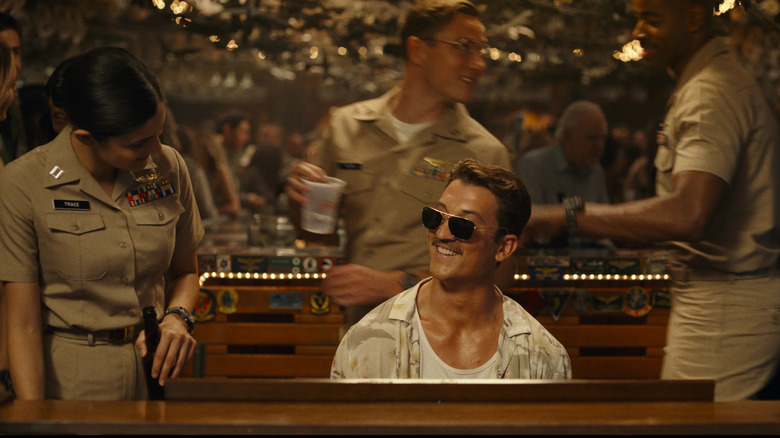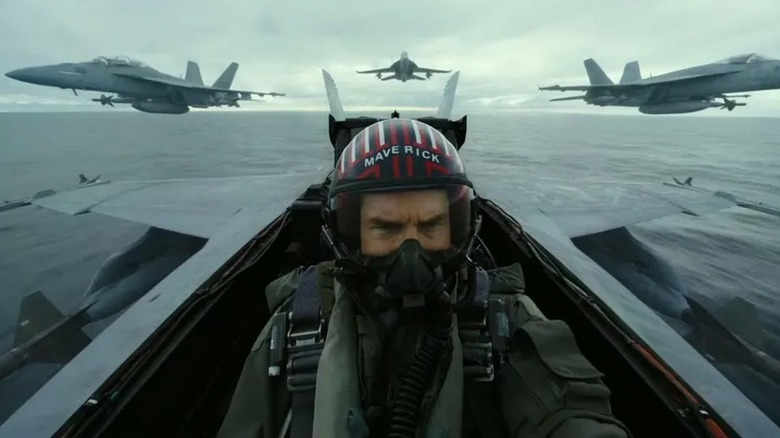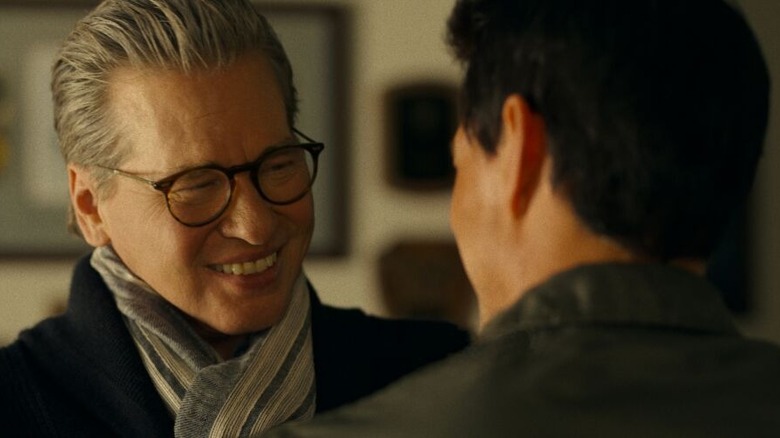Top Gun: Maverick Editor Eddie Hamilton Felt The Weight Of Expectations [Exclusive Interview]
Editor Eddie Hamilton didn't know "Tom Gun: Maverick" was going to resonate as strongly as it did. "Strongly" is probably an understatement, given how audiences around the world fell in love with the sequel. It's a rare blockbuster with a tangible sense of awe and wonder, not to mention a brain, heart, and soul to go along with the artful showmanship.
Months after the film broke box office records and became a serious awards contender, Hamilton couldn't be prouder. "Honestly, we felt the weight of expectation every day," he told us. "And to have people really enjoying it when, let's be honest, most people didn't think they would. They thought they would be disappointed. The fact that they're not, and some people are saying that it might even be they enjoyed it more than the first 'Top Gun,' is beyond our wildest dreams that people like the film that much." Hamilton, who also edits Christopher McQuarrie's "Mission: Impossible" films, recently explained to us how he helped craft such satisfying spectacle.
'The pressure on everybody on the crew for this film to be a slam dunk, we all felt it for two years'
This is such an economical movie. Was the structure pretty nailed down after it was shot, or did it take a long time to get it to that place?
It was very long. No, I mean, I have this theory that the easier a film looks when you watch it, the harder it was to make, which is completely true. Like any creative process, stuff starts out long and lumpy and unfocused. It takes a very long time to slowly compress it, to focus every single scene on the exact emotional response that you're trying to deliver for the audience, and to make sure that every sequence is played from Maverick's point of view, because he's the protagonist.
The first assembly was difficult to watch because it just wasn't focused and it was quite long. The aerial sequences didn't really make sense because when we first watched the movie through, there were no aerial sequences in there because it was the last thing we did. We filmed for a few months to do the ground story and then we started on the aerial sequences. It took a very long time for it all to come together.
Then you realize that the core emotional thrust of the movie is this relationship between Maverick and Rooster. If every scene doesn't lean into that, then you are not going to get such a great payoff at the end emotionally when they resolve their differences. I mean, it was a very, very long, slow process to really get those scenes to work. Even something like setting up Maverick in the Darkstar at the beginning, to get the tone of all that stuff exactly right was really challenging. To find the right score when he's flying and he can see the curvature of the earth and he says, "Talk to me, Goose," it was hard to find the tone of the music there. It's kind of warm, and we call it "the love of aviation" cue. But it took us a very, very long time to find that tone, so that you have that warm hug when he's flying and he's taking the Dark Star to mach 10. And then, of course, the score builds to a crescendo and then you find yourself deep in the sound design of the plane pushing up towards mach 10. The suspense in gently pushing a stick forward to try and get to that point.
It was a challenge to get everything to land correctly. There are scenes that we took out because they didn't support that. If something didn't work, we would quite often go back and take another swing at it. They'd go back the next day and we'd pick up additional angles on actors where we needed to support something or where the emotional resonance wasn't quite landing or truthful for whatever reason.
The relationship between Maverick and Penny was very hard to get exactly right. There were other scenes. Here's a fun fact for you: The scene where he rides with Penny on the motorbike after the beach football scene, that originally was situated after the sailing scene. But it was too early for them to have that kind of relationship with her on the back of the bike, resting her head on his shoulder. If you see the shot, she's wearing the clothes from the sailing scene, but instead, we changed her white pants blue to make them look like jeans in visual effects.
But because you are right in the emotion of that scene with the football and right at the end, the ball gets thrown to Hondo and they all pile on Hondo and they have a laugh and the music's building, and then you see Maverick and Penny riding home and then you get there — it's a very short shot; it's 12 seconds or something — he pulls up and she's wearing completely different clothes, but you don't notice because you are in the emotion of the movie.
That's an example of, you have to dial the emotions so carefully through the entire movie to make sure that nothing bumps at all. And there was a whole extra scene [during] the beach football where Cyclone talked to Maverick and we were like, "No, he's just got to walk away before he says all that stuff." All this is dialed in and takes a long time to figure out. It's not necessarily stuff that you can figure out on the page, either. It's stuff that you discover during the process of putting the movie together. I think it's a testament to the experience of Joe Kosinski, Jerry Bruckheimer, Tom Cruise, and Chris McQuarrie that they embraced that evolution of the story and the emotional clarity of each sequence.
We embraced the organic nature of filmmaking, which is where you have to have a plan, but leave yourself open to discoveries on the day. Then if something doesn't work, figure out a way to go back and film additional shots to help the process land. But the other thing to remember, Jack, is the pressure on everybody on the crew for this film to be a slam dunk, we all felt it for two years. Three years for Joe and [cinematographer] Claudio [Miranda], because it took them almost a year to figure out how to put planes in the cameras. For me, it was a two-year journey of editing the film.
I was desperate for it not to suck, because I'm a fan. I've been to see films and been desperately disappointed over the years. I didn't want the audience to have that experience. Everyone's going in with their arms crossed, because everyone thinks, "Well, why are you even trying this? It's going to fail. It's a poison chalice. What are you doing trying to make a sequel to 'Top Gun'?"
Tom was aware of that as well, and he said, "We got to start the same way. Harold Faltermeyer's 'Top Gun' anthem into the 'Danger Zone,' get everyone to uncross their arms and lean in so that they feel like we care." Same typeface for the opening type and all of that stuff. They are tiny, tiny details, but it just shows that we really care. Every detail of the movie has been carefully thought through and we want to win you over in those first two minutes, so that you lean in and then we can reintroduce you to Maverick and then take you back to Top Gun. We wanted you to feel like you were back in the world, the feeling of the world that Tony Scott had created in 1986. We all felt that. We didn't know if we'd got it, but thank heavens the audiences responded well.
'You're constantly allowing the film to talk to you and tell you what it needs'
Thank you for the detailed answer. I now have a lot of follow-ups.
Okay, hit me.
Transitioning from the beach to Tom Cruise and Jennifer Connelly on the motorcycle, that shot screams Tony Scott, just that fade.
Yes, yes, yes, yes.
How much did you think of Tony Scott when editing the movie?
Listen, I have seen all of Tony's Scott's movies many times. I think one of my favorites is "Man on Fire," I think that's fantastic. "Domino," interestingly, I think he went up to 11 and it doesn't work as well. I think "Man On Fire" was the apex of the aggressive editorial style that he discovered with his editors, obviously, but I thought "Domino" went slightly too far.
He admitted that, too.
What was interesting is when you realize the textures that he created for the original "Top Gun" with the filters that he used on the camera and the choice of lenses, when we were trying to recreate that feeling, we discovered how incredibly difficult it is to create. It gives you an enormous additional level of respect for what that entire team did in 1985 and 1986 when the movie came out.
I got Chris Levinson, one of the editors of the original "Top Gun," who also did "Days of Thunder" and worked with Tony Scott many times, he came on to help me when I was totally overwhelmed with footage for a few months. I got to ask him all my questions about working with Tony Scott. He was a gentleman and obviously a phenomenally good editor. He did "Enemy of the State” as well, which is an astonishingly well-edited film.
The other thing that you do as an editor is you respond to the material that you have. You never impose anything on the material that you have. You're constantly allowing the film to talk to you and tell you what it needs to make it as good as it can be. Each shot has its own organic life in the world of the film. And so, an experienced editor will look at all the footage and then figure out what is the best film that exists in this footage, regardless of what I thought I was going to be imposing on it creatively. I have to just make the most of it.
I wasn't aggressively pursuing a Tony Scott style, necessarily, but it was in the back of my mind the whole time. Actually, the very first dogfight sequence where we use "Won't Get Fooled Again" by The Who, where Maverick is shooting down the pilots and they're doing all the push-ups, I remember with Joe Kosinski — we would watch the montage from "Days of Thunder” quite a lot, the "Give Me Some Lovin'" montage, which introduces the relationship with Tom Cruise's character and Robert Duval's character. It crosscuts between all these different races and it's setting up the rivalry that Tom has with the other drivers. It's very efficient, indeed. It's an amazing montage and it's funny and it's full of little character beats and details.
We wanted to create that similar sense of a very exciting, compressed montage for that first dogfight sequence, which took a long time. It started out as a 15-minute sequence and came down to a 12-minute sequence and then got it down to a six-minute sequence. And then in the final finished movie, it's about four minutes and 50 seconds. You can see how much I was compressing and throwing it out to get it down to that incredibly efficient, very, very tight, very snappy, exciting style.
'It's really important that you don't watch the film, you feel the film'
In that training montage, Maverick is showing the kids how it's done. There's a meta quality there of Cruise showing the world, "This is how you make a blockbuster, people."
It is in a way, yeah. Tom was aware — he had a Spidey-sense about the fact that streaming was coming. There's this tidal wave coming through the industry. And he really loves theatrical. I love theatrical. I love the communal experience of going to a theater and watching a movie on a big screen with awesome sound. For me, it's the best thing. It's complete magic when you go and you watch a great movie with an audience for two hours. I love it with all my heart. I've had so many wonderful experiences in my life watching movies with a crowd in a theater.
And he wanted to try and persuade the industry that there was still validity in that. Let's be honest: Early in 2022, streaming was very in fashion and theatrical was very much on the back foot, obviously because of the pandemic. But Tom was like, "No, no, no, we have to demonstrate to the industry that the crowds will show up for a movie and remind everybody of the joy of a movie, of that communal experience of watching a film in a theater, when everyone is laughing and when everyone is excited and when everyone is emotional at the end of the film, when everyone laughs."
We know for a lot of people that "Top Gun" was their first movie back in cinemas after they hadn't been for two years, so it was terrific that we were able to play our part in course correcting the industry, I think, back towards theatrical. Certainly, I feel that is undeniable now, when you hear David Zaslav talking about it and talking about the importance of theatrical to Warner Brothers now.
It was, in a way, Tom reminding audiences of that, but that's always what he wanted. He tries to make films which resonate emotionally with an audience. It's really important that you don't watch the film, you feel the film. That's constantly what he's telling us. The audience has to feel it. You don't want them observing it. You want them to be on an emotional journey, which is completely seamless from beginning to end, which is almost the holy grail of a movie.
When you watch a film like that, you almost don't want to come off the ride because you love it so much. You want to stay in the world of the film. Again, I've felt like that at times in my life. I remember "Dances with Wolves" was one where I saw it and I was stunned. "Braveheart" was another one. I was just completely stunned. I literally sat in the theater afterwards overwhelmed emotionally by what I'd seen. I wanted to go in and watch the movie immediately again, which I did with both of those films.
It's also very exciting, because I feel like there might be young kids who hadn't been to a movie theater for two or three years, and their parents took them to see "Top Gun." So, one of their earliest memories of moviegoing will be seeing this incredible film and it might start their love affair with movies. There might be a whole generation of kids out there who talk about "Top Gun: Maverick" as being something that lit the fire of creativity in them or something.
I remember when I saw "Star Wars” when I was eight years old, it was a lightning bolt for me. The way that everyone who works at ILM talked about "King Kong" or "Seventh Voyage of Sinbad" being a lightning bolt for them growing up, it's the experience that you can pass on to the next generation, which is quite exciting. Tom is all about that as well.
Did your love of "Star Wars" feel like a full-circle moment here? The third act here of hitting the target is very "Star Wars."
Yeah, we were all joking about the thermal exhaust port right below the main port all the time, I promise you. That joke never got old. But Luke Skywalker doesn't get shot down and get reunited with Han Solo behind enemy lines, and then they steal a TIE fighter and they have to fight their way out. So, you don't get quite the same experience.
But yes, hands up, we were all very aware of it. I think as the film evolved, we became more and more aware of the similarities with "Episode IV." I remember when we were up at Skywalker doing our temp mixes, I met Ben Burtt, who was the sound designer on "Star Wars." I said to him, "I've read these stories of the editors on 'Star Wars' using World War II dogfight footage filmed off a television on 16 millimeter as templates for where the TIE fighters and the X-wings would be moving through the air, so that ILM had an idea of how fast the planes were going to move and stuff."
Ben had on his laptop a QuickTime movie, a side by side of the original work print from "Star Wars” and the finished movie. He said, "Eddie, this is a real treat for you. Have a look at this." So I got to see that. I had just spent months of my life building the final mission sequence, the action sequence for "Top Gun: Maverick." It was like three months of work to build that first assembly from the moment they take off the carriers to the moment they crash land at the end.
So I was in awe of what they did, because that sequence in "Star Wars: Episode IV" is still brilliant today when you watch it, but they did it on film. And I had all the new cogs and widgets of an Avid media composer to help me, and the fact that it's all non-linear and incredibly fast and I can find stuff instantly. So I did have enormous respect for what they achieved with that.
'There's no shortcuts'
You mentioned months of work involved with the finale. Can you walk me through it step by step?
There's no shortcuts. I would try and break down the footage on a daily basis as it came in, but sometimes I would fall behind just from the sheer quantity of it. But I would break it down. Literally, I'm watching it and anything that I see that I think might be useful for the movie, even if it's a three out of 10 shot, I'll put it in a timeline, and I'll start building timelines of shots that I think might be useful for this piece of the story.
Sometimes I'll grade them with different amounts of green markers. Avid allows you to add these little markers. For the best shots, I'll put on a higher video track. Visually, I can see the ones that are on the bottom video track are not as good. And as we go up, they get better. And so, I have ways of reminding myself what I thought was a good shot when I first went through the footage.
The process, you do these select rolls where you are going, "Well, this is everything I could use when Maverick and the pilots first arrive in the clouds and then they dive down. And then this is everything I've got where they're going over the water towards the enemy territory. And then this is what I've got for when they're entering the enemy territory. This is everything where they go under the bridges. This is everything where Rooster's slowing down. This is everything where Maverick and Phoenix are climbing up." All that stuff, I have it broken down.
It takes so long because it's very time consuming and I don't want to miss anything. If Tom Cruise walks in and goes, "Is this the best shot?" I want to say yes, because I've been through it all. I've got five other options stacked up to show him, "This is why I think, for these two seconds of action, this is the best shot, but I've also got this one and this one and this one. If you want to choose another one, that's fine."
Once you've got that, I then go back and I'll then just watch the footage for the first bit in the clouds. I'll start to get a sense of the shots that are great and the way that the actors' eyelines all link together, so you feel like the pilots are looking at each other, even though they're all filmed days and days apart. They all dive down through the clouds on different days, but you are using your imagination to try and connect them all together. You're making sure that Maverick is thinking about Rooster and Rooster's looking nervous at the water. You slowly build it, and it starts out way too long.
I remember when I first finished that sequence, when Maverick does the cobra over Rooster and fires the flares and Maverick gets shot down. Phoenix is going, "Dagger One is hit, Dagger One is hit, Maverick is down," and then you've got that long shot where you're pushing towards Rooster as he's thinking about what he's going to do. He's being ordered back to the carrier, but he's thinking about, "Do I stay and help Maverick?" Hopefully, the audience is feeling that dilemma in him at that point.
I remember when I finished that after three months, the sense of relief that I'd got to the end of a draft, however bad it was. It actually was quite watchable; it was just long, but it was very watchable and very exciting. You could definitely feel that it was going to work. I remember Tom Cruise coming in on a Saturday and he's like, "Have you done it, Eddie? How's it looking?" I was like, "Yeah, it's long, but I think we've got it." He sat, watched it, and he was like, "That is definitely going to work. It's long and it needs a lot of work, but it's definitely going to work eventually."
We could all see the emotional thread was going to be possible to string out through that whole sequence. We'd done the homework of teaching the audience about the stakes of the mission through the entire movie leading up to that. We don't have to do exposition because you understand they've got two and a half minutes, they've got to fly this low and this fast, and the enemy fighters are coming. You understand all that, so there's no teaching the audience that stuff in the third act.
'You can still feel the spirit of Iceman and the decades of friendship there'
Earlier you mentioned that sometimes the most challenging scenes are the most simple on paper. For the scene between Iceman and Maverick, what's the challenge in handling all those emotions?
Yeah, yeah. Here's the thing to remember: That scene plays from Maverick's point of view. When you are editing, point of view is critically important. Maverick is the protagonist. Everything is bounced off Maverick. You are connected with his thoughts through the entire scene with Iceman. The first shot we see is Maverick walking into the room, then we cut to his point of view of Iceman, then we cut back to Maverick reacting to seeing his friend in this condition and him making the decision to move forward and sit down. Then when Iceman's typing, you always cut to Maverick looking over at the screen, then you cut to the screen. You are always seeing it through his point of view. We are playing shots for a long time on Tom Cruise without cutting away, so there are raw emotional shots where we're choosing not to cut. You are left with the character confronting his emotions.
What I love about Val Kilmer's performance is there is a playfulness to it. It's humorous. When he's pointing at the screen and going, "I want to talk about work," you can still feel the spirit of Iceman and the decades of friendship there, even though they're not speaking. Sometimes he just gave these wonderful looks, which we use. Tom is looking and his friend is looking at him and waiting for him to come to these realizations about his relationship with Rooster, or the fact that he can't give up being a fighter pilot because that's who he is.
Though it was difficult, we trod very carefully and we refined it endlessly. Again, we felt the weight of expectation. That scene had to deliver. It had to thread this needle for the audience, who know that Val Kilmer has had health issues and can't speak very well, so they're like, "Well, how are they going to handle this?" I remember reading a version of the scene where he spoke every line of dialogue and didn't type it, and we filmed it just in case. But I remember talking to Joe and saying, "Look, if he only says one thing right at the end of the scene and it takes enormous effort then to say it, it will have so much more resonance and you'll feel so much more from the scene between those two characters." So we ended up finding that. And we refined what he typed. Initially what was scripted wasn't there, so we refined it. We went back and had another crack at some extra angles in that scene to make sure that the stuff worked.
Yes, it was a challenge, but I'm really glad that it worked. It wasn't easy. Nothing worked the first time. Everything was refined and developed and we would leave it alone and come back and refine it again. I mean, every single frame of this movie was stress tested over and over again. I can't tell you the number of times. I've seen the film hundreds of times, which is the job of an editor, but also what is necessary to make something which works and feels effortless to watch.
"Top Gun: Maverick" is now available on Digital, 4K Ultra HD, Blu-ray, and DVD.
